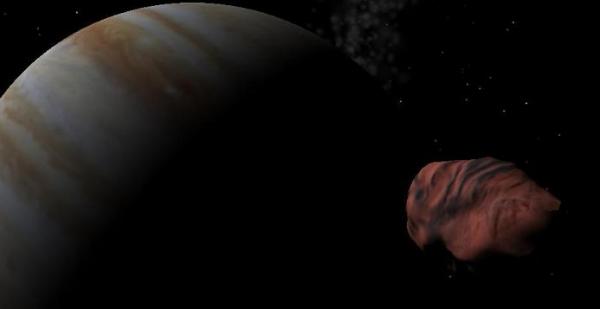BY LETTER
Amalthea
Galactography > Regions of Space > Inner Sphere
Galactography > Other Major Polities, Empires, and Meta-Empires > Solsys Organization
Galactography > Systems and Worlds > Systems & Worlds A - B
Galactography > Other Major Polities, Empires, and Meta-Empires > Solsys Organization
Galactography > Systems and Worlds > Systems & Worlds A - B
 Image from Steve Bowers |
During the early Information Age, measurements of the density of Amalthea first showed it to be far less dense than previously thought. It appeared to consist of several huge boulders barely touching each other covered in loose ice- much easier to mine, but not suitable for excavating the interior to make living chambers.
In 218 a consortium of antimatter miners attempted to disassemble Amalthea to create an electromagnetic ring collection system, but came into conflict with colonists who wished to use the moon for living space. The colonists won this conflict in 220 A.T. and began to burrow into the moon, both in search of resources and shelter from Jupiter's strong magnetic field and radiation belts.
The colonists formed the Jovian League in 278 AT, and extracted silicon, aluminium, oxygen, and titanium and water ice from this moon, while constructing low-gravity habitats in the resultig excavations. Due to its position in the Jovian magnetic field the moon was a net producer of electromagnetic energy, and became one of the richest self-contained habitats in Jovian Space. A Bernal Sphere was constructed in 300 to provide centrifugal gravity.
The symbol of the Amalthean polity was a goat, derived from the role of the mythical Amalthea as a milkmaid. At this time most citizens of the Jovian League were genetically modified Genetekkers of one family or another; the Amaltheans were heavily modified to withstand the severe radiation in that location. The Genetekkers maintained sophisticated genetic laboratories deep inside the moon's centre. Following several decades of goat obsession most citizens chose to splice goat DNA into their already highly modified genome and were at least partly caprine.
Always a reluctant member of the Genetekker supraclade the Amaltheans remained in Sol system rather than flee to Lalande 21185 and Frog's Head. Goatmen and satyrs descended from Amaltheans are found in various locations throughout the Civilized Galaxy, sometimes associated with nature worship or even satanism.
Related Articles
Appears in Topics
Development Notes
Text by Steve Bowers
Initially published on 29 December 2002.
Initially published on 29 December 2002.






